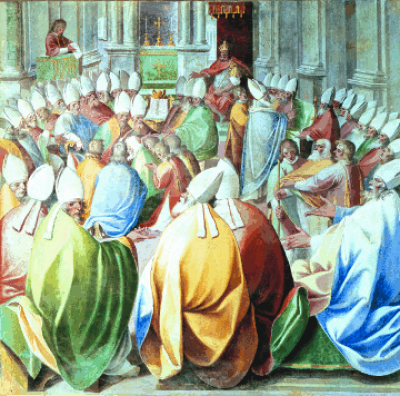Photios I (Greek: , Phtios; c. 810/820 6 February 893), also spelled Photius (), was the ecumenical patriarch of Constantinople from 858 to 867 and from 877 to 886. He is recognized in the Eastern Orthodox Church as Saint Photios the Great.
Photios is widely regarded as the most powerful and influential church leader of Constantinople subsequent to John Chrysostom's archbishopric around the turn of the fifth century. He is also viewed as the most important intellectual of his time "the leading light of the ninth-century renaissance". He was a central figure in both the conversion of the Slavs to Christianity and the Photian schism, and is considered "[t]he great systematic compiler of the Eastern Church, who occupies a similar position to that of Gratian in the West," and whose "collection in two parts...formed and still forms the classic source of ancient Church Law for the Greek Church."Photios was a well-educated man from a noble Constantinopolitan family. Photios's great uncle was a previous patriarch of Constantinople, Saint Tarasius. He intended to be a monk, but chose to be a scholar and statesman instead. In 858, Emperor Michael III (r. 842867) decided to confine Patriarch Ignatius in order to force him into resignation, and Photios, still a layman, was appointed to replace him. Amid power struggles between the pope and the Byzantine emperor, Ignatius was reinstated. Photios resumed the position when Ignatius died (877), by order of the Byzantine emperor. The new pope, John VIII, approved Photios's reinstatement. Catholics regard as legitimate a Fourth Council of Constantinople (Roman Catholic) anathematizing Photios, while Eastern Orthodox regard as legitimate a subsequent Fourth Council of Constantinople (Eastern Orthodox), reversing the former. The contested councils mark the end of unity represented by the first seven Ecumenical Councils.
Photios was canonized by the Eastern Orthodox Church in 1847.
The Fourth Council of Constantinople was the eighth ecumenical council of the Catholic Church held in Constantinople from October 5, 869, to February 28, 870. It was poorly attended, the first session by only 12 bishops and the number of bishopes later never exceeded 103. In contrast the pro-Photian council of 879–80 was attended by 383 bishops. The Council met in ten sessions from October 869 to February 870 and issued 27 canons.
The council was called by Emperor Basil I the Macedonian, with the support of Pope Hadrian II. It deposed Photios, a layman who had been appointed as Patriarch of Constantinople, and reinstated his predecessor Ignatius.
The Council also reaffirmed the decisions of the Second Council of Nicaea in support of icons and holy images and required the image of Christ to have veneration equal with that of the gospel book.A later council, the Greek Fourth Council of Constantinople, was held after Photios had been reinstated on the order of the emperor. Today, the Catholic Church recognizes the council in 869–870 as "Constantinople IV", while the Eastern Orthodox Churches recognize the councils in 879–880 as "Constantinople IV" and revere Photios as a saint. Whether and how far the Greek Fourth Council of Constantinople was confirmed by Pope John VIII is a matter of dispute. There is substantial evidence that he did in fact accept it, anathematising the council of 869 in his Letters to the Emperors Basil, Leo and Alexander, which were read in the second session of the 879/80 council, his letter to Photios and his Commonitorium. Francis Dvornik has argued that subsequent popes accepted the council of 879 as binding, only choosing the council of 869–70 as ecumenical 200 years later after the Great Schism due to issues with certain canons (namely the implicit condemnation of the filioque). Siecienski disagrees with Dvornik's assessment. The previous seven ecumenical councils are recognized as ecumenical and authoritative by both Eastern Orthodox and Catholic Christians.

 English
English  español
español  français
français  português
português  русский
русский  العربية
العربية  简体中文
简体中文 
